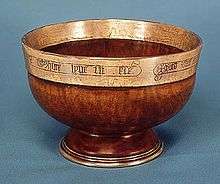Mazer (drinking vessel)

In the Germanic tradition, a mazer is a special type of drinking vessel, properly made of maple wood, and so-called from the spotted or birdseye marking on the wood (Ger. Maser, spot, marking, especially on wood; cf. measles).
Description
These drinking vessels are shallow bowls without handles, with a broad flat foot and a knob or boss in the centre of the inside, known technically as the print. They vary from simple, wooden affairs, to those ornamented with metalwork. They were made from the 11th to the 16th centuries, and were the most prized of the various wooden cups in use, and so were ornamented with a rim of precious metal, generally of silver or silver gilt; the foot and the print being also of metal.[2] There are examples with wooden covers with a metal handle, such as the Flemish and German mazers in the Franks Bequest in the British Museum. On the metal rim is usually an inscription, religious or bacchanalian, and the print was also often decorated. The later mazers sometimes had metal straps between the rim and the foot.
A few were turned very finely, normally from burr maple (Acer campestre). Both the wood and the vessels made of it were known as "mazer" so in contemporary accounts sometimes they are referred to as ciphis de mazer (drinking bowl of burr maple wood) and sometimes simply as a "mazer". The best mazers had silver or silver gilt rims added, commonly prints were also added (a decorated disc in the base of the bowl) and occasionally normally on later mazers a silver or gilt foot was also added.
Surviving examples
About 63 medieval mazers are known to survive, and show the evolution of the mazer from a plain, wooden implement, to those with decorative rims. 13th and 14th century rims tend to be simple plain rims only about 1 cm deep without lettering, 15th and 16th century rims are very characteristic with a very deep (3–4 cm moulded form) often with lettering. One exception to this rule is the mazer which Samuel Pepys drank from in 1660 (on display in the British Museum), the rim of this mazer is hallmarked 1507/8 but it is of the earlier simple form. The best collection on display is at the Museum of Canterbury, where ten 13th and 14th century mazers are shown. A very fine mazer with silver gilt ornamentation 3 inches deep and 9 1/8 inches in diameter was sold in the Braikenridge collection in 1908 for £2,300. It bears the London hall-mark of 1534.
See also
References
| Wikisource has the text of the 1911 Encyclopædia Britannica article Mazer. |
-
 This article incorporates text from a publication now in the public domain: Chisholm, Hugh, ed. (1911). "article name needed". Encyclopædia Britannica (11th ed.). Cambridge University Press.
This article incorporates text from a publication now in the public domain: Chisholm, Hugh, ed. (1911). "article name needed". Encyclopædia Britannica (11th ed.). Cambridge University Press. - St. John Hope, W.H., 'On the English Medieval Drinking Bowls Called Mazers' Archaeologia 50 (1887), pp. 129-193
- "A Short History of Drinking Bowls and Mazers" (PDF). PDF Document. Robin Wood. Retrieved 2008-06-04.
Notes
- ↑ "Mazer". Metalwork. Victoria and Albert Museum. Retrieved 2007-08-18.
- ↑ Wood, Robin (2005). The Wooden Bowl. Ammanford: Stobart Davis. p. 181. ISBN 9780854421305. OCLC 123111733.
External links
- Medieval & Renaissance Mazers
- Eichhorn, Markus (November 2011). "The Maple Tree". Test Tube. Brady Haran for the University of Nottingham.
